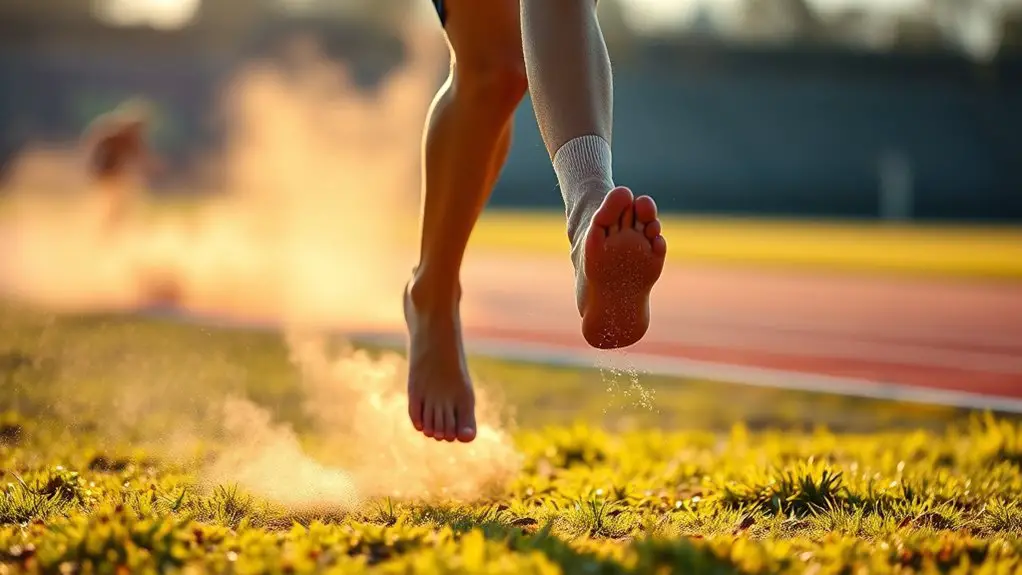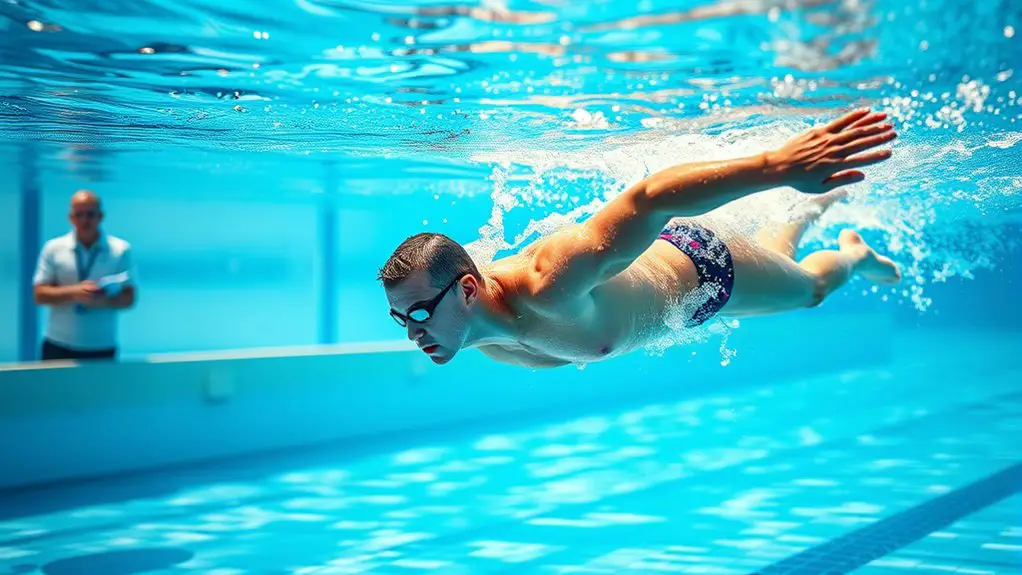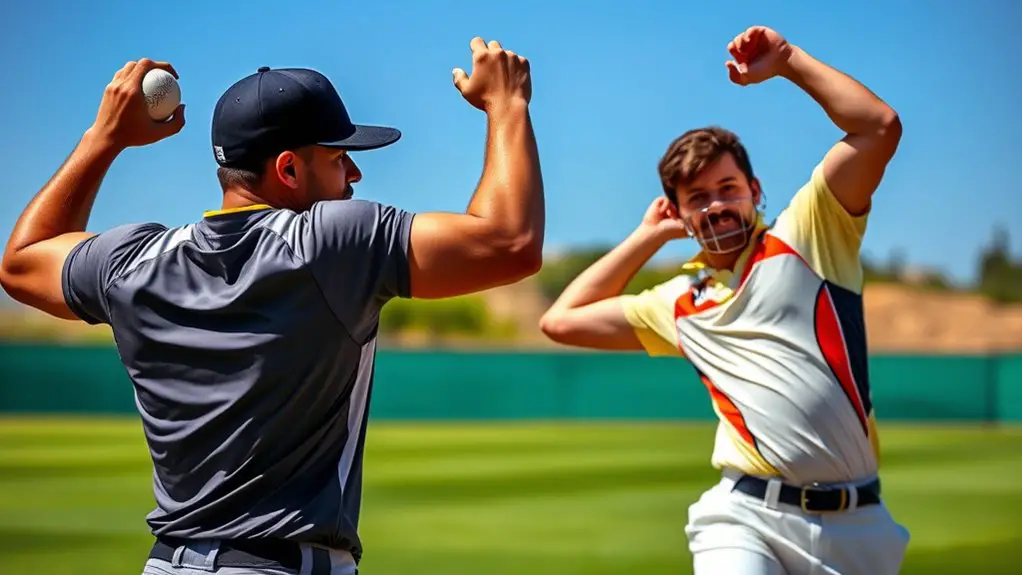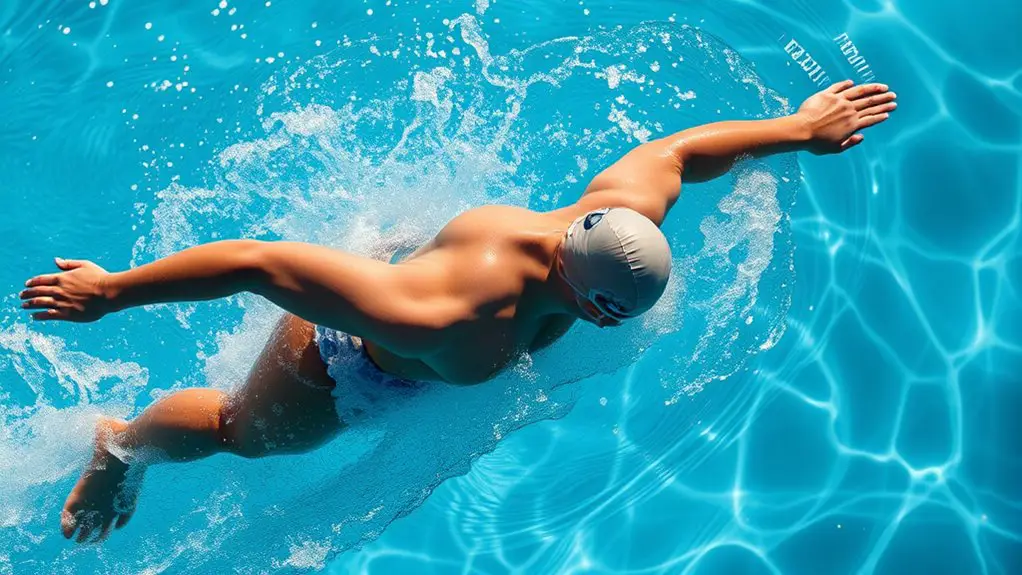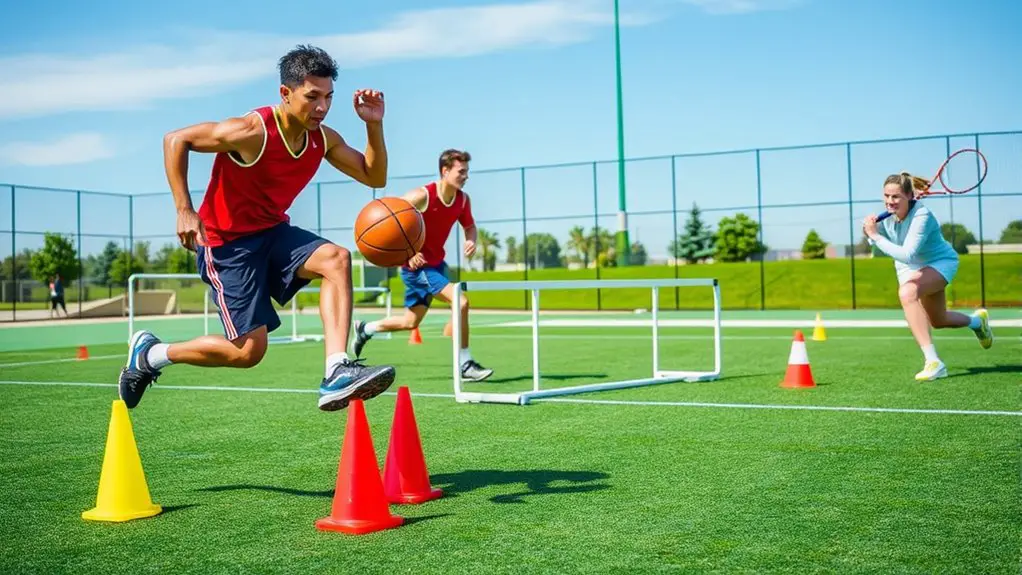Barefoot sprinting enhances your force production by promoting a more natural running style. As you make the shift, you'll notice better muscle engagement, especially in your calves and feet. This improved ground connection helps optimize your ground reaction forces, which are vital for propulsion. You'll also experience smoother landings and better stride mechanics. If you're curious about the nuances of adapting your technique and the potential performance benefits, there's much more to explore.
The Science of Force Production in Sprinting
When you think about sprinting, it's easy to overlook the intricate mechanics of force production that drive your speed. Understanding force application is essential for anyone who craves the exhilaration of sprinting freely. When you're sprinting, your body generates force through a powerful combination of muscle engagement and proper sprint mechanics. Each stride requires a careful balance of pushing off the ground and pulling your body forward, creating momentum that propels you ahead.
Your foot placement and timing are critical; they directly influence the effectiveness of your force application. A quick, explosive push can help you maximize speed, while inefficient mechanics can hold you back. By refining your technique, you can access a sense of freedom in your sprinting, feeling the wind rush past as you master the art of movement. Embracing these principles will not only enhance your performance but can also elevate your overall sprinting experience. Additionally, incorporating squats and lunges into your training routine can significantly boost your lower body strength and improve your sprinting mechanics.
Biomechanical Changes When Sprinting Barefoot
Sprinting barefoot can lead to significant biomechanical changes that enhance your running efficiency. When you're unshod, your foot strike naturally shifts to a more midfoot or forefoot position. This change helps you land more softly, reducing the impact on your joints and promoting a smoother stride. You'll notice increased muscle activation in your calves and feet, which helps strengthen these areas over time.
Without the cushioning of shoes, your body adapts by engaging more stabilizing muscles, resulting in better balance and coordination. You might also find your stride lengthening and your cadence increasing as you become more attuned to the ground beneath you. These adjustments not only make you feel more connected to the earth but also allow you to run with greater freedom and efficiency. Embracing barefoot sprinting could reveal a new level of performance that feels both liberating and natural. Additionally, core strength plays a vital role in stabilizing your body during these adaptations, enhancing overall performance.
Impact of Ground Reaction Forces on Performance
Although many runners underestimate it, understanding ground reaction forces (GRFs) is essential for optimizing performance. When you sprint barefoot, the way your body interacts with the ground changes appreciably. GRFs are the forces exerted by the ground in response to your foot striking it. These forces influence how you distribute your weight and propel yourself forward. By paying attention to force distribution, you can enhance your sprinting efficiency.
Feeling the ground beneath your feet allows for a more natural connection, which can lead to better timing and coordination in your movements. Embracing this connection helps you harness the power of GRFs, allowing you to adapt your technique for improved speed. Ultimately, understanding how these forces work can reveal your potential, giving you the freedom to run with greater effectiveness and confidence. Plyometric training can also complement your sprinting efforts, enhancing your explosive power. Embrace the ground beneath you, and let it elevate your performance.
Reduced Injury Risk and Its Relationship to Force Production
As you explore barefoot sprinting, you might find that reduced injury risk is closely linked to how force is produced and absorbed during each stride. By embracing a more natural running style, you optimize force production, allowing your body to adapt better to the ground's feedback. This freedom of movement lets your muscles, tendons, and ligaments work in harmony, enhancing injury prevention.
When you're barefoot, you're more likely to engage your feet's intrinsic muscles, which strengthens your overall structure and improves your stability. This connection to the ground fosters a better understanding of your body's limits and helps you avoid overstriding or missteps that can lead to injuries.
Ultimately, force optimization during barefoot sprinting not only enhances your performance but also creates a safer running experience. With every stride, you're tapping into a more instinctual way of moving, allowing for greater freedom and reduced risk of injury. Additionally, maintaining proper warm-ups and stretching routines can further minimize the risk of sprains and strains that may arise from sudden movements.
Differences Between Barefoot and Shod Sprinting
When you compare barefoot and shod sprinting, you'll notice some key biomechanical differences. These differences can affect ground reaction forces and ultimately impact your performance. Understanding these factors can help you make more informed choices about your running style.
Biomechanical Differences Explained
While many athletes may not realize it, the choice between barefoot and shod sprinting can lead to significant biomechanical differences. When you sprint barefoot, your body often makes biomechanical adaptations that enhance your overall movement. These adaptations can improve your force efficiency, allowing you to generate more power with less effort. Without the cushioning of shoes, you might instinctively adjust your stride, landing more on the midfoot or forefoot than the heel. This shift can lead to better muscle engagement and improved proprioception, giving you a greater sense of freedom in your movements. In contrast, shod sprinting may promote a different gait, potentially limiting these benefits. Embracing barefoot sprinting might just reveal your true potential and redefine your running experience.
Ground Reaction Forces
The differences in ground reaction forces between barefoot and shod sprinting can considerably impact your performance and injury risk. When you sprint barefoot, your foot strike often leads to a more natural, forefoot landing, allowing for a better connection with the ground surface. This connection can enhance your proprioception, helping you feel the nuances of the terrain beneath you. In contrast, running in shoes can alter your foot strike pattern, typically leading to a heel strike that may generate higher impact forces. These differences in ground reaction forces can influence how your body absorbs shock and distributes weight, ultimately affecting how you move. Embracing barefoot sprinting might provide you with a greater sense of freedom and improved biomechanics.
Impact on Performance
Although many factors contribute to sprinting performance, the choice between barefoot and shod running can considerably influence your speed and efficiency. Running barefoot often enhances speed adaptation, allowing your body to develop a more natural stride and better mechanics. With less cushioning, you'll engage more muscles, potentially leading to improved power output. This can translate to faster sprints.
On the other hand, shod running might feel more comfortable initially, but it can increase energy expenditure due to extra weight and cushioning. This added energy cost could slow you down. Ultimately, the choice between barefoot and shod sprinting isn't just about comfort; it's about optimizing your performance and embracing the freedom to run in a way that feels natural to you.
Training Considerations for Transitioning to Barefoot Sprinting
As you consider moving to barefoot sprinting, it's crucial to recognize the significant changes your body will undergo. Shifting away from traditional footwear means your feet need time to adapt to new ground sensations and forces. Start by selecting footwear that allows for some exposure to the ground while still offering minimal protection—this bridges the gap before going fully barefoot.
Incorporate adaptation strategies gradually; begin with short distances on softer surfaces to condition your feet and muscles. Focus on your running form, ensuring you land lightly and maintain proper posture. Listen to your body—if you feel discomfort, slow down and allow more recovery time. This process isn't just about shedding shoes; it's about embracing a new way of moving that can lead to greater freedom and connection with the ground. Additionally, incorporating mobility training can enhance your adaptability to this new running style. Enjoy the journey, and let your body guide you in this exciting shift!
Expert Opinions on Barefoot Sprinting and Performance Enhancements
While many athletes swear by barefoot sprinting for enhancing performance, expert opinions on the subject vary considerably. Some experts argue that ditching shoes can lead to improved biomechanics and greater force production, allowing you to connect more with the ground. They highlight performance benefits, like increased muscle engagement and natural gait, which can elevate your speed and efficiency. However, others caution against potential risks, such as injuries from overuse or improper technique. These expert insights emphasize the importance of gradual shift and proper form to reap the rewards of barefoot sprinting without setbacks. Ultimately, it's about finding what works best for you while embracing that sense of freedom in your movement. Whether you're an experienced sprinter or just starting out, weighing these opinions can help you make informed decisions on your sprinting journey. Remember, your body knows best, so listen closely to its signals. Additionally, incorporating strength training into your regimen can further enhance your overall performance and reduce the risk of injury.
Frequently Asked Questions
Can Barefoot Sprinting Improve Overall Athletic Performance?
Absolutely, barefoot sprinting can enhance your overall athletic performance. It encourages better muscle activation, helping you engage more muscle fibers effectively. Plus, it promotes natural movement patterns, which can lead to injury prevention. You'll feel a sense of freedom as you connect with the ground, improving your agility and speed. By embracing this approach, you might just find yourself breaking personal records while enjoying the thrill of a more liberated running experience.
What Types of Surfaces Are Best for Barefoot Sprinting?
Did you know that studies show barefoot running can increase proprioception by up to 30%? When it comes to surfaces, grass surfaces are often favored for their cushioning effect, while sand surfaces provide a unique challenge that strengthens your feet. Track surfaces offer consistency and speed, perfect for honing technique. Trail surfaces, with their varied terrain, can enhance your agility and adaptability. Each surface gives you a different experience, allowing for freedom in your sprinting journey.
How Long Does It Take to Transition to Barefoot Sprinting?
Shifting to barefoot sprinting usually takes several weeks to a few months, depending on your current foot strength and running experience. You'll need an adaptation period to allow your feet to adjust, which helps reduce injury risk. Start with short distances on softer surfaces, gradually increasing as your comfort grows. Embrace the freedom of feeling the ground beneath you, but don't rush the process—patience will pay off in the long run!
Are There Specific Footwear Alternatives for Partial Barefoot Training?
Imagine slipping into a second skin for your feet. If you're eyeing alternatives for partial barefoot training, minimalist shoes could be your ticket to freedom. They provide just enough protection while allowing your foot strength to flourish. These lightweight options encourage natural movement, helping you connect with the ground beneath you. As you shift, your feet will thank you for the opportunity to strengthen and adapt without the constraints of traditional footwear.
Does Barefoot Sprinting Affect Running Speed in Distance Events?
Barefoot sprinting can definitely impact your running speed in distance events. You'll find that the barefoot benefits, like improved proprioception and a more natural stride, can enhance your performance. As you embrace the distance dynamics, you might notice increased efficiency and reduced risk of injury. By connecting more with the ground, you're likely to experience a sense of freedom in your movements, allowing you to push your limits and enjoy the run even more.
